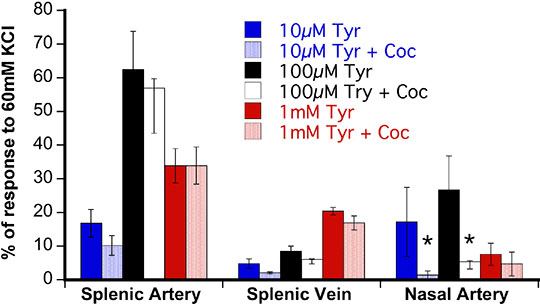Comparison of the Effect of Tyramine on Nasal and Extra-nasal Blood Vessels From the Pig Introduction: Orally-active nasal decongestants such as phenylephrine and pseuodoephedrine are thought to act by causing either direct or indirect vasoconstriction in the nasal mucosa and, therefore, reduce mucosal volume (Eccles et al., 2005). While pseudoephedrine is known to release noradrenaline from vascular nerve endings (Kobayashi et al 2003), there is little known regarding the relative importance of this effect in arteries and veins and the role of α-adrenoceptor subtypes. In the present study we have examined the effect of tyramine, a lipophilic indirect sympathomimetic, in the porcine nasal artery and extra-nasal vessels of the spleen. Method s: Ring segments of porcine isolated splenic artery and vein and the nasal artery were prepared for isometric tension recording in isolated organ baths containing Krebs-Henseleit solution gassed with 95% O2/5% CO2, and maintained at 37°C. Segments were exposed to cumulative concentrations of tyramine in presence and absence of 30 µM cocaine. Responses have been expressed as a percentage of the response to 60 mM KCl and compared by a Wilcoxon test (p < 0.05) is considered a significant difference). In the nasal artery responses to 100 µM tyramine were also examined the presence of either 0.1 µM prazosin, or 0.1 µM RX-811059, antagonists selective for α1-adrenoceptors and α2-adrenoceptors, respectively (Wright et al., 1995). Results : Figure 1 shows that all three preparations responded to increasing concentration of tyramine with a contraction, but in the arteries (but not the splenic vein) the cumulative response was biphasic. Cocaine (30 µM) inhibited tyramine-induced responses in the nasal arery, but did not significantly affect responses in splenic artery and vein (Fig 1). Both 0.1 µM prazosin (0.6±0.5%, n=5) and 0.1 µM RX-811059 (3.6±1.4%, n=5) reduced contractions to 100µM tyramine (24.9±5.3%, n=5) in the nasal artery.

Figure 1 Comparison of the effect of 30µM cocaine on tyramine-induced responses (n=6-8). * - denotes a significant difference (p < 0.05) from control responses. Discussion: These results demonstrate that the porcine nasal and extra-nasal arteries are more sensitive to tyramine than the splenic vein, but only in the nasal artery did we find evidence for an action consistent with the involvement of neuronal noradrenaline. Since both prazosin and RX-811059 inhibited tyramine-induced contraction of the nasal artery, both α-adrenoceptor subtypes could be implicated in the therapeutic action of indirectly-acting nasal decongestant. Further experiments with pseudoephedrine are warranted. Eccles R, Jawad MS, Jawad SS et al., (2005) Am. J. Rhinol. 19, 25-31. Kobayashi S, Endou M, Sakuraya F, et al. (2003). Anesthesia and Analgesia 97, 1239-1245. Wright IK, Blaylock NA, Kendall DA, Wilson VG (1995). Br. J. Pharmacol. 114, 678-688.
|


